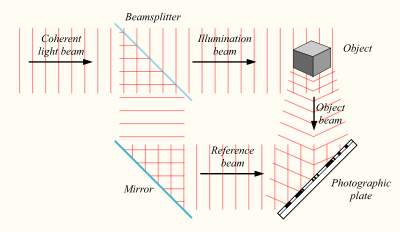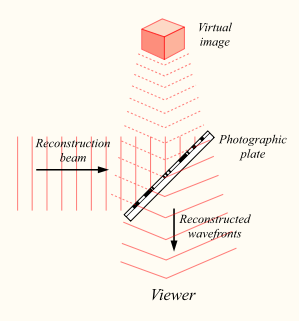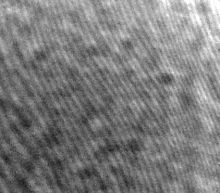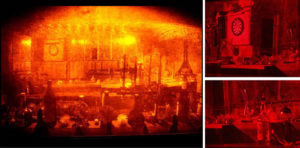Construction and Reconstruction Of Image On Hologram:
Holography is a technique that enables a light field, which is generally the product of a light source scattered off objects, to be recorded and later reconstructed when the original light field is no longer present, due to the absence of the original objects. Holography can be thought of as somewhat similar to sound recording, whereby a sound field created by vibrating matter like musical instruments or vocal cords, is encoded in such a way that it can be reproduced later, without the presence of the original vibrating matter
Laser Holography:
In laser holography, the hologram is recorded using a source of laser light, which is very pure in its color and orderly in its composition. Various setups may be used, and several types of holograms can be made, but all involve the interaction of light coming from different directions and producing a microscopically fine interference pattern which a plate, film, or other medium photographically records. 
In one common arrangement, the laser beam is split into two, one known as the object beam and the other as the reference beam. The object beam is expanded by passing it through a lens and used to illuminate the subject. The recording medium is located where this light, after being reflected or scattered by the subject, will strike it. The edges of the medium will ultimately serve as a window through which the subject is seen, so its location is chosen with that in mind. The reference beam is expanded and made to shine directly on the medium, where it interacts with the light coming from the subject to create the desired interference pattern.

Like conventional photography, holography requires an appropriate exposure time to correctly affect the recording medium. Unlike conventional photography, during the exposure the light source, the optical elements, the recording medium, and the subject must all remain perfectly motionless relative to each other, to within about a quarter of the wavelength of the light, or the interference pattern will be blurred and the hologram spoiled. With living subjects and some unstable materials, that is only possible if a very intense and extremely brief pulse of laser light is used, a hazardous procedure which is rare and rarely done outside of scientific and industrial laboratory settings. Exposures lasting several seconds to several minutes, using a much lower-powered continuously operating laser, are typical.
Apparatus:
A more flexible arrangement for recording a hologram requires the laser beam to be aimed through a series of elements that change it in different ways. The first element is a beam splitter that divides the beam into two identical beams, each aimed in different directions:
- One beam (known as the illumination or object beam) is spread using lenses and directed onto the scene using mirrors. Some of the light scattered (reflected) from the scene then falls onto the recording medium.
- The second beam (known as the reference beam) is also spread through the use of lenses, but is directed so that it doesn’t come in contact with the scene, and instead travels directly onto the recording medium.
Several different materials can be used as the recording medium. One of the most common is a film very s
imilar to photographic film(silver halide photographic emulsion), but with a much higher concentration of light-reactive grains, making it capable of the much higher resolution that holograms require. A layer of this recording medium (e.g., silver halide) is attached to a transparent substrate, which is commonly glass, but may also be plastic.
Process Of Construction and Reconstruction Of Image On Hologram:
When the two laser beams reach the recording medium, their light waves intersect and interfere with each other. It is this interference pattern that is imprinted on the recording medium. The pattern itself is seemingly random, as it represents the way in which the scene’s light interfered with the original light source but not the original light source itself. The interference pattern can be considered an encoded version of the scene, requiring a particular key the original light source in order to view its contents.
This missing key is provided later by shining a laser, identical to the one used to record the hologram, onto the developed film. When this beam illuminates the hologram, it is diffracted by the hologram’s surface pattern. This produces a light field identical to the one originally produced by the scene and scattered onto the hologram.

